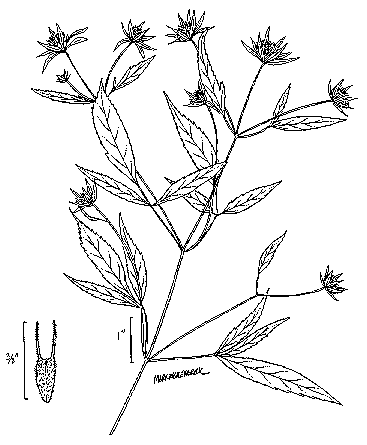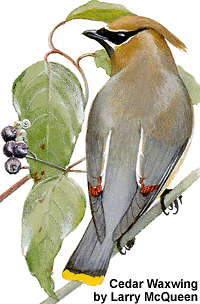 Bidens Frondosa...a mystery solved?
Bidens Frondosa...a mystery solved? Bidens Frondosa...a mystery solved?
Bidens Frondosa...a mystery solved?
Many of you observed this plant growing profusely on the banks
of the large pond at the Sebastopol Preserve and have wondered what
it was. Leaves compound, stalked, dividing into 3-5 leaflets.
Height: 1-4', the leaflets are lance-shaped, toothed. Flower head
dull, yellowish blooming through October. Leafy bracts support
flower head. Fruit is flat and barbed, with two prongs extending
from one end. This plant grows throughout the United States and
is considered a "North American" native. Muskrats feed on
this plant; ducks will also feed on bidens
frondosa.
Some of the more colorful names that have been given to
this plant are: Hitchhiker ticks, Beggar-Ticks, Old Ladies'
Clothespins, Devil's Pitchfork, and Common Bur-Marigold. All of
these names refer to the two-pronged, barbed fruit, which has a
tendency to attach to passers-by. But the barbed fruit doesn't
exist just to be called funny names; it is actually an evolutionary
development that helps the plant seeds spread and grow. An "Old
Ladies' Clothespin" attaching to the coat of a passing raccoon will
be carried far from its parent plant and begin to grow somewhere
else. If no animals are around, the fruit's flat shape allows it to
be carried by the wind, and the barbs and prongs help it to
establish itself in new ground without being blown
away.
Lets Ponder: Have you found your pants littered with "hitchhikers ticks?" Where were you were at the time?
 How Leaves Change Color: From the Fall Bouverie Notebook
How Leaves Change Color: From the Fall Bouverie Notebook
The change of leaf color during autumn is one of nature's most
spectacular shows. The process of leaf-color-change is fairly
complex and not fully understood by botanists. The green of
chlorophyll, the pigment which gives leaves their color and is
central to photosynthesis, is not the only pigment in leaves:
it is the most abundant pigment. Other pigments called
carotenoids are also present in leaves but in much smaller
quantities. The carotenoid pigments give leaves their yellow
and orange colors; they also give carrots, egg yolks and corn their
colors. Because of the greater amount of green chlorophyll
pigmentation, the carotenoid pigments are obscured. As the
photo period shortens and photosynthesis slows down the green of
chlorophyll is slowly lost, revealing the orange and yellow colors
that were already present in the leaves.
The red, purple and blue colors are different from the yellows
and oranges in that they are not present year round. These
colors are the "anthocyanins." Strong sunlight during the autumn,
coupled with low night-time temperatures, favors the conversion of
leaf-sugar into anthocyanins. Not every autumn has these
conditions, so the abundance of anthocyanin colors varies from year
to year. An early hard freeze does not permit a plant
sufficient time to prepare for winter by going through its normal
processes. A hard freeze simply kills a plant's leaves
outright. The leaves turn brown and eventually fall
off.
Lets Ponder: Notice which leaves are turning yellow and which leaves are turning red.
 Cedar Waxwings - flocking to our trees now!
Cedar Waxwings - flocking to our trees now!
Cedar Waxwings may be seen in flocks now all over the Laguna - foraging in the trees for berries and catching bugs on the wing. Look for the yellow underbelly, red tips on the wings with yellow at the base of the tail and the exotic crest on the head with a black mask. Listen for the very high pitched "tsee-tsee-tsee-tsee" at the tops of trees. The Cedar Waxwing is one of the few temperate dwelling birds that specializes in eating fruit. It can survive on fruit alone for several months. Unlike many birds that regurgitate seeds from fruit they eat, the Cedar Waxwing defecates fruit seeds. It is vulnerable to alcohol intoxication and death after eating fermented fruit.
The name "waxwing" comes from the waxy red appendages found on the tips of the secondaries of some birds. The exact function of these tips is not known, but they may serve a signaling function in mate selection.
Cedar Waxwings with orange instead of yellow tail tips began appearing in the northeastern United States and southeastern Canada beginning in the 1960s. The orange color is the result of a red pigment picked up from the berries of an introduced species of honeysuckle. If a waxwing eats the berries while it is growing a tail feather, the tip of the feather will be orange.
Lets Ponder: An easy location to observe Cedar Waxwings is in the Sebastopol Town Square!